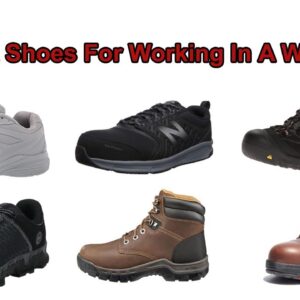
Flat sole work boots are a type of work boot that has a flat sole, providing stability and support to the wearer. Unlike work boots with heels, flat sole work boots keep the foot closer to the ground, offering greater balance and traction on slippery or uneven surfaces.
Flat sole work boots are often preferred for jobs that require standing or walking, as they reduce fatigue and discomfort. They are also popular for outdoor activities such as hiking and camping, as they provide good support and protection for the feet.
There are many different types of flat sole work boots available, each with its own unique features and benefits. Some common types of flat sole work boots include:
- Safety-toe boots: These boots have a steel or composite toe cap that protects the foot from impact and compression injuries.
- Waterproof boots: These boots are made from waterproof materials that keep the feet dry in wet conditions.
- Insulated boots: These boots are lined with insulating materials that keep the feet warm in cold weather.
- Electrical hazard boots: These boots are designed to protect the wearer from electrical hazards.
1. Stability
Stability is an important factor to consider when choosing work boots, especially for those who work in hazardous environments or on slippery surfaces. Flat soles provide a stable base of support, which helps to reduce the risk of slips and falls. This is because a flat sole distributes weight evenly across the foot, providing a more secure footing. In contrast, boots with heels can cause the foot to roll inward or outward, which can lead to instability and falls.
Flat sole work boots are often used in industries such as construction, manufacturing, and warehousing, where workers are required to stand or walk for long periods of time on uneven surfaces. They are also popular for outdoor activities such as hiking and camping, where stability is essential for traversing rough terrain.
In addition to providing stability, flat sole work boots can also help to reduce fatigue and discomfort. This is because a flat sole allows the foot to move more naturally, which reduces stress on the muscles and tendons. As a result, flat sole work boots can help to improve productivity and reduce the risk of injuries.
2. Comfort
Comfort is an important consideration when choosing work boots, especially for those who are required to stand or walk for long periods of time. Flat soles are more comfortable than boots with heels because they distribute weight evenly across the foot, reducing pressure on the balls of the feet and heels. This can help to reduce fatigue and discomfort, and can also improve productivity.
Flat sole work boots are often used in industries such as construction, manufacturing, and warehousing, where workers are required to stand or walk for long periods of time on hard surfaces. They are also popular for outdoor activities such as hiking and camping, where comfort is essential for long days on the trail.
In addition to providing comfort, flat sole work boots can also help to reduce the risk of injuries. This is because they provide good support for the feet and ankles, which can help to prevent sprains and strains. Flat sole work boots can also help to reduce the risk of plantar fasciitis, a common condition that causes pain in the heel and arch of the foot.
Overall, the comfort of flat sole work boots is an important factor to consider when choosing work boots. Flat soles can help to reduce fatigue and discomfort, improve productivity, and reduce the risk of injuries.
3. Traction
Flat soles provide good traction on slippery or uneven surfaces, making flat sole work boots ideal for a variety of applications. This is because a flat sole distributes weight evenly across the foot, providing a more secure footing. In contrast, boots with heels can cause the foot to roll inward or outward, which can lead to instability and falls.
- Grip: Flat soles provide good grip on a variety of surfaces, including wet, icy, and oily surfaces. This is important for workers who need to be able to move around safely on slippery surfaces, such as construction workers, warehouse workers, and factory workers.
- Stability: Flat soles provide stability on uneven surfaces, such as rocks, gravel, and dirt. This is important for workers who need to be able to walk and work on uneven surfaces, such as landscapers, farmers, and miners.
- Durability: Flat soles are made from durable materials that can withstand wear and tear. This is important for workers who need boots that will last for a long time, such as construction workers and factory workers.
- Comfort: Flat soles are comfortable to wear for long periods of time. This is important for workers who need to be able to stand or walk for long periods of time, such as retail workers and warehouse workers.
Overall, the traction provided by flat soles is an important factor to consider when choosing work boots. Flat soles provide good grip, stability, durability, and comfort, making them ideal for a variety of applications.
4. Support
In the context of flat sole work boots, the supportive nature of flat soles plays a crucial role in enhancing comfort, safety, and overall performance. Here are some key facets to explore:
- Stability: Flat soles provide a stable base of support, which helps to reduce fatigue and discomfort while standing or walking for long periods. This stability is particularly important for workers in physically demanding jobs or those who work on uneven or slippery surfaces.
- Arch support: Many flat sole work boots are designed with arch support, which helps to distribute weight evenly across the foot and reduce stress on the arches. This can help to prevent foot pain and injuries, such as plantar fasciitis.
- Ankle support: Flat sole work boots often have a higher ankle cut than other types of work boots, which provides additional support and stability for the ankles. This is especially important for workers who need to climb ladders or work on uneven surfaces.
- Cushioning: Some flat sole work boots are equipped with cushioning in the soles, which helps to absorb shock and reduce impact on the feet and joints. This can help to improve comfort and reduce the risk of injuries.
Overall, the support provided by flat soles is a key factor in the design and performance of flat sole work boots. By providing stability, arch support, ankle support, and cushioning, flat soles help to ensure that workers are comfortable, safe, and productive on the job.
5. Safety
Flat sole work boots are designed to provide a stable and comfortable base for workers in various industries. The inclusion of safety features, such as steel toes and puncture-resistant soles, enhances the protective capabilities of these boots, making them suitable for hazardous environments and high-risk job sites.
Steel toes are incorporated into the front of the boots, offering protection against impact and compression injuries. This feature is crucial for workers who operate heavy machinery, work with sharp objects, or are exposed to falling objects. Steel toes help to safeguard the feet from potential injuries, reducing the risk of fractures and amputations.
Puncture-resistant soles are designed to withstand sharp objects, such as nails, screws, and metal shards, from penetrating the boots and causing foot injuries. This feature is particularly important for workers in construction, manufacturing, and other industries where sharp objects are commonly encountered. Puncture-resistant soles provide an additional layer of protection, ensuring that workers can perform their tasks safely and with peace of mind.
The combination of steel toes and puncture-resistant soles in flat sole work boots provides comprehensive foot protection, reducing the risk of workplace injuries and enhancing overall safety. These features are essential for workers in various industries, helping to prevent accidents and protect their feet from potential hazards.
6. Durability
The durability of flat sole work boots is a critical aspect that contributes to their overall quality and performance. The materials used in the construction of these boots are carefully selected to ensure that they can withstand the rigors of various work environments and provide long-lasting protection to the wearer.
One of the key factors contributing to the durability of flat sole work boots is the use of high-quality leather. Leather is a natural material known for its strength, toughness, and resistance to wear and tear. Full-grain leather, which is the strongest and most durable grade of leather, is often used in the construction of premium flat sole work boots. This type of leather is characterized by its dense fibers and natural grain, providing excellent protection against abrasions, punctures, and other forms of damage.
In addition to leather, other durable materials such as nylon, polyurethane, and rubber are also commonly used in the manufacturing of flat sole work boots. These materials are lightweight, flexible, and resistant to chemicals, moisture, and extreme temperatures. The combination of these materials ensures that the boots can withstand the demands of various work environments, including construction sites, warehouses, and factories.
The durability of flat sole work boots is not only limited to the materials used in their construction but also extends to the design and craftsmanship of the boots. Well-constructed boots feature reinforced stitching, sturdy eyelets, and solid outsoles that are resistant to wear and tear. These design elements contribute to the overall longevity of the boots, ensuring that they can provide reliable protection and support for extended periods of time.
In conclusion, the durability of flat sole work boots is a key factor that determines their suitability for various work environments. The use of high-quality materials, combined with robust construction and design, ensures that these boots can withstand tough conditions, provide long-lasting protection, and deliver reliable performance over time.
FAQs on Flat Sole Work Boots
This section addresses commonly asked questions and misconceptions about flat sole work boots, providing informative answers to enhance understanding and decision-making.
Question 1: What are the primary advantages of flat sole work boots?
Flat sole work boots offer several advantages, including enhanced stability, improved comfort during prolonged standing or walking, superior traction on slippery or uneven surfaces, and better support for the feet and ankles.
Question 2: Are flat sole work boots suitable for all work environments?
Flat sole work boots are well-suited for various work environments, particularly those that involve standing or walking on hard surfaces for extended periods. However, for tasks requiring additional ankle support or protection against specific hazards, other types of work boots may be more appropriate.
Question 3: Do flat sole work boots compromise safety features?
Not necessarily. Flat sole work boots can be equipped with safety features such as steel toes for impact protection and puncture-resistant soles to safeguard against sharp objects. These features ensure the wearer’s safety without compromising the stability and comfort offered by flat soles.
Question 4: How do flat sole work boots contribute to foot health?
Flat sole work boots promote foot health by providing good arch support, reducing stress on the feet and ankles, and preventing common foot problems such as plantar fasciitis. The even distribution of weight across the foot helps maintain proper foot alignment and reduces fatigue.
Question 5: What factors should be considered when choosing flat sole work boots?
When selecting flat sole work boots, consider factors such as the materials used, the level of protection required, the type of work environment, the fit and comfort of the boots, and any additional features or certifications that may be necessary.
Question 6: How can flat sole work boots be maintained to ensure longevity?
Proper maintenance is crucial for extending the lifespan of flat sole work boots. Regular cleaning, conditioning of leather boots, and periodic inspections for wear and tear will help preserve their protective qualities and ensure continued comfort and support.
In summary, flat sole work boots offer a combination of stability, comfort, traction, and support, making them ideal for various work environments. Understanding their benefits, limitations, and proper care ensures that users can make informed choices and maximize the performance of their work boots.
Transition to the next article section: Understanding the diverse applications of flat sole work boots across different industries and job roles.
Tips for Using Flat Sole Work Boots
Flat sole work boots offer numerous benefits in various work environments. Here are some tips to optimize their use and maximize their effectiveness:
Tip 1: Choose the Right Material
The material of your flat sole work boots significantly impacts their durability and performance. Opt for high-quality leather, such as full-grain leather, for exceptional strength and resistance to wear and tear. Other durable materials include nylon, polyurethane, and rubber, which offer flexibility and resistance to chemicals and extreme temperatures.
Tip 2: Ensure a Proper Fit
Properly fitting flat sole work boots are crucial for comfort and safety. Your boots should fit snugly without causing discomfort or restricting movement. Consider the shape of your feet and any orthotics or insoles you may need for additional support.
Tip 3: Maintain Your Boots Regularly
Regular maintenance extends the lifespan of your flat sole work boots. Clean them frequently to remove dirt and debris. Leather boots should be conditioned periodically to preserve their integrity and prevent cracking. Inspect your boots regularly for any signs of wear or damage.
Tip 4: Use the Right Socks
Wearing appropriate socks can enhance the comfort and performance of your flat sole work boots. Choose moisture-wicking and breathable socks to keep your feet dry and prevent blisters. Consider socks with arch support or cushioning for added comfort.
Tip 5: Break in Your Boots Gradually
New flat sole work boots may require a break-in period to adjust to the shape of your feet. Wear your boots for short periods initially and gradually increase the duration to prevent discomfort or blisters.
Summary:
By following these tips, you can optimize the use of your flat sole work boots, ensuring they provide maximum comfort, safety, and durability in your work environment. Proper care and attention to detail will extend the lifespan of your boots and enhance your overall work experience.
Transition to the article’s conclusion:
In conclusion, flat sole work boots offer a versatile and practical solution for various work environments. By choosing the right material, ensuring a proper fit, maintaining them regularly, using the right socks, and breaking them in gradually, you can maximize their benefits and enjoy a comfortable and safe work experience.
Conclusion
Throughout this exploration, we have delved into the world of flat sole work boots, uncovering their unique advantages and applications. These boots provide exceptional stability, enhanced comfort, superior traction, and reliable support for the feet and ankles.
In various work environments, flat sole work boots empower individuals to perform their tasks confidently and efficiently. They are particularly well-suited for jobs that require prolonged standing or walking on hard surfaces, reducing fatigue and the risk of foot-related injuries.
When selecting flat sole work boots, consider factors such as the materials used, the level of protection required, the type of work environment, the fit and comfort of the boots, and any additional features or certifications that may be necessary.
By choosing high-quality flat sole work boots and maintaining them properly, you can maximize their lifespan and ensure they continue to provide the support and protection you need. Remember, investing in durable and comfortable work boots is an investment in your safety, productivity, and overall well-being.



